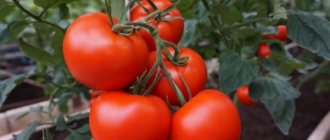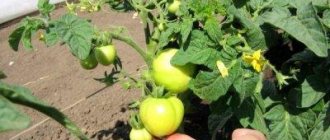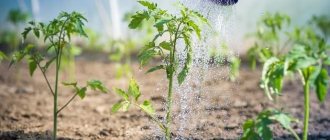Loading…
Loading…
In 2014, breeders from the UK presented a new tomato variety called Rapunzel at an agricultural exhibition in the United States. A hybrid with an unusual appearance, despite its “youth,” has already won the hearts of many gardeners who have figured out how to grow a Rapunzel tomato and share their secrets with colleagues.
Tomatoes "Rapunzel": description of the variety
| Variety name | Rapunzel |
| general description | Early maturing hybrid of indeterminate type |
| Originator | FloraNova, Britain |
| Ripening period | 70-80 days |
| Form | Small round |
| Color | Red |
| Average weight of tomatoes | 15-30 grams |
| Application | Fresh |
| Productivity of the variety | up to 1 kg per hand |
| Features of cultivation | Very light-loving tomatoes |
| Disease resistance | Resistant to most diseases and pest attacks |
The Rapunzel tomato belongs to the indeterminate varieties of tomatoes.
The height of its bushes, which are not standard, can range from 180 to 240 centimeters. Read about determinate varieties here. This variety is a hybrid, but does not have hybrids of the same name . This is an early ripening variety, its growing season ranges from 70 to 80 days. Breeders recommend growing these tomatoes in patio containers, placing them on a windowsill or balcony.
But when growing Rapunzel tomatoes at home, you should take into account the significant height of these plants, since not every balcony can accommodate two-meter bushes. These tomatoes are also suitable for growing in greenhouses. Tomatoes of this variety are characterized by high resistance to diseases.
Rapunzel tomatoes are characterized by small, round and elastic fruits, reminiscent of cherry tomatoes. Beneath their glossy, bright red skin lies sweet and juicy flesh. The Rapunzel tomato variety is very prolific; one brush contains up to 40 fruits, arranged compactly and neatly . They are distinguished by an average level of dry matter content and a small number of chambers. Not intended for long-term storage.
You can compare the weight of the fruits of the Rapunzel variety with others in the table below:
| Variety name | Fruit weight (grams) |
| Rapunzel | 15-30 |
| Broody | 90-150 |
| Andromeda | 70-300 |
| Pink Lady | 230-280 |
| Gulliver | 200-800 |
| Banana red | 70 |
| Nastenka | 150-200 |
| Olya-la | 150-180 |
| Dubrava | 60-105 |
| Countryman | 60-80 |
| Golden Jubilee | 150-200 |
How to care
Caring for Rapunzel tomatoes involves standard steps for caring for plants in the garden:
- watering;
- feeding;
- garter;
- loosening and weeding of the soil;
- hilling;
- stepsoning.
Watering
After the seedlings have been planted in a permanent place, after 12 days you need to start watering. The first moistening can be carried out together with preventive treatment against late blight by pouring in a solution of potassium permanganate (2 g / 10 l of water).
Before the buds begin to bloom, it will be necessary to consume about 4 liters of water per 1 square meter. m. And during flowering and formation of ovaries - up to 12 liters.
It is necessary to remember that tomatoes do not tolerate waterlogging - this contributes to the development of diseases caused by fungi, which threatens the appearance of cracks in the fruits and a deterioration in their taste. In turn, insufficient moisture causes the ovaries to crumble and small fruits to form.
It is necessary to water tomatoes only with warm water - no colder than 20 °C. It needs to be settled or collected after precipitation.
The procedure is carried out 1-2 times every 7 days. The best time to moisturize is in the evening, after the sun has set, or a couple of hours before sunset. Watering should be done so that water does not get on the foliage and stems.
The optimal humidity for growing tomatoes is 85–90%.
Tomatoes can be watered manually - using a hose (under the root, excluding moisture from entering the plants) - and using the subsoil drip method.
Important! You can find out whether the tomatoes are watered enough by squeezing a lump of earth taken from a depth of 10 cm in your palm. A well-molded and disintegrating lump indicates sufficient moisture.
Drip watering is considered the best watering for tomatoes. This can be done using plastic bottles, in which large and small holes have been previously made and the bottom has been cut off. Such bottles are placed in holes with a depth of 10–15 cm at a distance of 15–20 cm from the stem at an angle of 30–40° and covered with earth. The liquid poured into bottles gradually goes into the soil and saturates the roots with moisture. These bottles are also convenient for applying fertilizers.
It is important not to forget about spraying - it is better to carry it out in conjunction with foliar feeding and antifungal treatments.
Feeding
It is recommended to carry out 4 feedings of tomatoes:
- the first - 2 weeks after planting;
- the second - 10 days after the first;
- the third - 2 weeks after the second;
- the fourth - 20 days after the third.
The following preparations are suitable for feeding tomatoes:
- "Gumi Kuznetsova";
- "Gumat-Universal";
- "Emerald",
- "Ideal" etc.
You can also add “green fertilizers” and organic matter.
Tomatoes are fertilized after abundant moisture. Root feeding must be alternated with foliar feeding. After the ovaries are formed, fertilizer can be applied only at the root.
Did you know? For a long period, residents of America and Europe considered tomatoes unfit for food due to their toxicity. The fact that these fruits were edible became known only after the American Robert Gibbon Johnson publicly ate a bucket of red tomatoes in 1820.
Stepsoning
As the tomato bush grows, it forms many side shoots or stepsons. A large number of them leads to thickening of plantings, contributes to the development of diseases caused by fungi, the formation of small fruits or their late ripening. To avoid these problems, pinching is carried out - removing the side shoots growing in the axils of the leaves. They are torn off by hand or cut off with scissors, leaving 5 cm “stumps”. As a result, only one main stem should remain.
The sooner additional stepsons are removed, the better the harvest will be obtained.
It is necessary to carry out pinching 1-2 times a week.
Soil care
The soil under plantings also requires regular care. After each watering and precipitation, it is loosened and hilled. This must be done carefully so as not to harm the root system.
To avoid loosening, you can mulch the soil. Mown grass is suitable for this. Mulching will also help fight weeds and drying out soil.
Hilling up is not a mandatory procedure. Each gardener decides for himself whether to do it or not.
As necessary, the row spacing should be cleared of weeds - they are removed along with the roots.
Find out also about the tomato variety "Auria".
Tying up a bush
Since Rapunzel tomatoes develop tall stems, they need to be tied up. This will protect them from breaking under the weight of the fruit.
For this purpose, pegs 1 m in height are driven in at a distance of 10–15 cm from the stem. The stems are tied to them with a rope.
Photo
And now we invite you to familiarize yourself with the Rapunzel tomatoes in the photo.
Characteristics
The above-mentioned tomatoes were bred in 2015 by the British company FloraNova. Today, buying seeds of these plants is very problematic. Following the description of Rapunzel tomatoes, we can conclude that they can be grown in any region when the creators finally decide to produce them for mass sale.
Rapunzel tomatoes are salad tomatoes and are most often eaten fresh . The Rapunzel tomato variety is characterized by high yields.
You can see the yields of other varieties in the table below:
| Variety name | Productivity |
| Rapunzel | up to 1 kg per hand |
| Kate | 15 kg per square meter |
| Nastenka | 10-12 kg per square meter |
| Crystal | 9.5-12 kg per square meter |
| Dubrava | 2 kg per bush |
| Red Arrow | 27 kg per square meter |
| Golden Jubilee | 15-20 kg per square meter |
| Verlioka | 5 kg per square meter |
| Diva | 8 kg per bush |
| Explosion | 3 kg per square meter |
| Golden heart | 7 kg per square meter |
Tomatoes of this variety have the following advantages:
- high productivity;
- excellent taste characteristics of the fruit;
- resistance to diseases.
The main disadvantage of such tomatoes is that their seeds are currently almost impossible to buy.
Read on our website: How to get an excellent harvest in open ground? How to grow delicious tomatoes all year round in a greenhouse? What features of caring for early varieties should every gardener know? And also why are growth stimulants, fungicides and insecticides needed when growing tomatoes?
Pre-sowing seed preparation
The Rapunzel hybrid tomato should be grown according to the technology for cultivating any hybrids and varieties of this popular vegetable crop. Due to the fact that Rapunzel tomato seeds are not sold through retail chains in our country, a significant part of gardeners are forced to use seed material obtained independently for planting, which requires a full range of pre-sowing preparations:
- determination of seed germination and viability through selective germination in optimal microclimatic conditions;
- sorting seed material by immersion in a saline solution. All tomato seeds that float to the surface must be discarded, and full-fledged seed should be washed several times with running water and dried to a free-flowing state;
- dressing seed material in order to prevent plant damage by fungal diseases using special means, among which the drug TMTD, used at the rate of 8 mg for every 10 g of seeds, is highly effective;
- good results are obtained by dusting the seed material with the biologically active preparation “Trichodermin-BL” at the rate of 10 g per 1 kilogram of tomato seeds;
At the stage of pre-sowing preparation, it is recommended to treat the seed material with physiologically active components
- you can replace chemical and biological products by etching in a solution of potassium permanganate, boric acid or ash solution;
- instead of the dressing procedure, tomato seeds should be subjected to heat treatment in the sun for 72 hours;
- One of the prerequisites for obtaining high-quality seedlings and productive plants is hardening. It is necessary to place the seeds in water, covering them by about 1/2, and then for two weeks alternate day and night temperatures within the range of 16−20 °C and 0−2 °C, respectively;
- Soaking seeds for several days has a positive effect on reducing germination time.
Features of cultivation
The main feature of this variety is its extreme love for sunlight. Following the description of the Rapunzel tomato variety, the soil should be kept acidic or slightly acidic. The distance between Rapunzel tomato bushes should be at least 50 centimeters . Plants should be planted in the spring, when the threat of frost has completely passed.
The depth of the planting hole should be at least 10 centimeters. To figure out how to grow Rapunzel tomatoes, you must first understand that this is a very tall plant with an unbranched root system. Therefore, from the moment of ripening, it is necessary to feed them with complex fertilizers every two weeks.
The following are often used as fertilizers for tomatoes: organic matter, mineral complexes, hydrogen peroxide, ammonia, yeast, iodine, ash, boric acid.
Since the bushes of this plant are quite tall, they need to be tied to a support, as well as formed into one or two stems. Watering should be carried out as the top layer of soil dries.
Some sources indicate that propagation of these tomatoes is carried out not with the help of seeds, but with the help of cuttings. If this information is correct, this means that in the near future domestic gardeners will not be able to acquire planting material. However, already in 2015, two British retailers were selling seeds of this type of tomato.
Read on our website: How to prepare the soil in a greenhouse in spring? What soil is best to use for growing seedlings and adult plants? What types of soil for tomatoes are there? And also, everything about the basic agricultural techniques: mulching, pinching, seedlings, planting in a permanent place.
Planting seedlings in a permanent place
Seedlings should be planted in a greenhouse or open ground when the weather outside is cool and cloudy, from approximately May 25 to June 10. Before planting, it is advisable to measure the soil temperature - it should be at least 18 °C.
It is necessary to maintain a distance of 35–40 cm between bushes. Planting patterns of 40×60 or 50×60 are used. The recommended row spacing is 50–60 cm. The depth of one planting hole is 10 cm.
The stems are buried a couple of centimeters into the soil. After planting, the plants are watered with warm water; 1.5–2 liters of water should be poured into each hole.
Important! The seedlings that will produce the highest yields should have thick stems 20–30 cm high, 3–4 pairs of large leaves, well-developed rhizomes and buds.
When planting in open ground, at first you will need to cover the seedlings with film. Also, young shoots must be insulated if the air temperature is below 17 °C.
If you are going to grow tomatoes on the balcony, then you need to purchase special containers for this.
Diseases and pests
Note! The Rapunzel tomato variety is practically not susceptible to diseases or pests.
However, breeders recommend carrying out preventive spraying of plants with Bordeaux mixture, and regularly spraying the aboveground part of the bushes with an infusion of onion and garlic, to which you need to add a little soap.
Read on our website: How to deal with tomato diseases in greenhouses? Which varieties are resistant to late blight and what do you need to know about protection against this disease? Alternaria, fusarium, verticillium, and late blight are the main enemies of nightshades. Are there varieties with good immunity and high yield?










